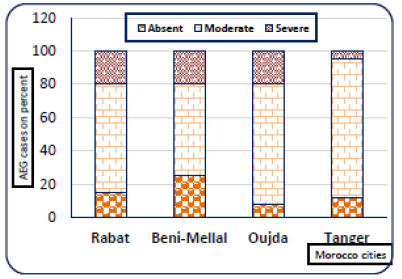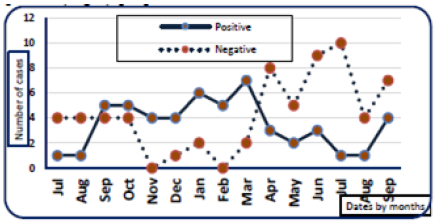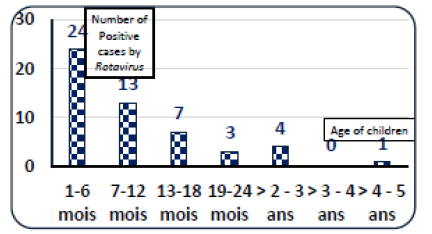Research Article 
 Creative Commons, CC-BY
Creative Commons, CC-BY
Epidemiological Approach by Retrospective Study of Rotavirus Acute Gastroenteritis in Children Under 5 Years of Age in the Oriental Region of Morocco
*Corresponding author: Khalid El Bekkaye UMPO, Laboratory of the Improvement of Agricultural Production, Biotechnology and the Environment, Faculty of Sciences, Mohammed First University, BP 717, Oujda 60000, Morocco.
Received: June 03, 2024; Published: June 17, 2024
DOI: 10.34297/AJBSR.2024.22.003028
Introduction
Intestinal infections are still one of the main causes of death and disability in developing countries [1]. Globally, an estimated 2 billion cases of diarrheal disease occur each year. Around 1.9 million children under the age of 5 years, mostly in developing countries, die from diarrhea every year. Abnormally loose or watery stools characterize diarrhea. Most cases of diarrhea are due to bacteria, viruses, or parasites. Digestive system disorders can also cause chronic diarrhea [2]. Diarrhea is one of the world’s leading killers of children, and rotavirus remains among the most common causes of severe diarrhea in children under the age of 5 years worldwide. An estimated of 185,300 children died from rotavirus in 2017 worldwide [3]. Rotavirus is the most common agent causing severe Acute Gastroenteritis (AGE) in children. Hospitalization is most often associated with dehydration, and younger children become dehydrated more quickly [4]. Rotavirus decreases the activities of digestive enzymes at the apical brush border membrane and inhibits sodium solute cotransport systems. Accumulation of carbohydrates in the intestinal lumen as well as malabsorption of nutrients and concomitant inhibition of water absorption can lead to a malabsorptive component of diarrhea [5]. The Department of Epidemiology and Disease Control (DELM) and the National Institute of Hygiene (INH), with the support of the WHO, have proposed to set up a surveillance system to monitor the spread of the disease. They have proposed setting up a Sentinel Surveillance System (SS) for rotavirus gastroenteritis in the four provinces of Morocco: Rabat, Tangier, Beni Mellal and Oujda, (Figure 1, 2) [6]. The doctor diagnoses gastroenteritis clinically. However, if a rotavirus is isolated in the fecal, the diagnosis of rotavirus gastroenteritis could be made in laboratory [7] (Figure 1,2).
Material and Methods
Biological diagnosis of rotavirus infections plays an important role in patient management and enables effective treatment and control of outbreaks. It is based on direct detection of viruses or viral antigens in fecal samples, which was taken under hygienic conditions to avoid contaminate it. The Rotavirus ELISA is an immunological test used to detect group A rotaviruses in fecal samples [8]. The test uses a polyclonal antibody to detect group- specific proteins, including the important internal capsid protein (VP6) present at group A rotaviruses [9,10]. This test provides a rapid, sensitive and specific method for detecting rotavirus in fecal samples. Maximum excretion of rotavirus in the fecal of patients with gastroenteritis has been reported to occur 3 to 5 days after the onset of symptoms. The selection of patients admitted to hospital met all the inclusion criteria and had no exclusion criteria:
i. Age less than 5 years,(<60 months).
ii. Presence of acute gastroenteritis (acute diarrhea).
iii. Child admitted to hospital for treatment (with dehydration).
During the 15 months between 2006 and 2007, 126 patients were admitted to the study for gastroenteritis. Children hospitalized for acute diarrhea in the pediatric ward at Oujda Al Farabi hospital were included in the sentinel surveillance; these children were sent either from health centers in rural areas in an urban area.
Results and Discussion
This study carried out in four Moroccan towns, and the results of the tests revealed the appearance of AEG with similar proportions in terms of degree of severity (Figure 1,2). The frequency and duration of symptoms were not specified in all cases. They were higher for diarrhea than for vomiting. Acute gastroenteritis to Rotavirus in children was most frequently implicated, across all age groups (Figure 1,2). Most children hospitalized for acute gastroenteritis came from urban areas. On the other hand, only a few children living in rural areas came to be treated for AEG. In addition, the hospitalization rate was higher for boys than for girls (58% Male and 42% female), (76% in urban and 24% in rural). The high incidence of rotavirus infections in infants and young children and their impact on the healthcare system was especially during the winter period [11] (Figure 3).
A study carried out in Guadeloupe between November 1997 and March 1998 found that there was an increase in the number of AEGs in March. This peak was mainly due to rotavirus [12]; Hospital admissions caused by rotavirus are largely seasonal; in several parts of the world, particularly rotavirus gastroenteritis appears to have a distinct seasonality [4]. Rotavirus gastroenteritis occurs mainly during the colder months in temperate climates and in all seasons in tropical countries, their incidence strongly linked to poor hygiene conditions [13]. One of the important data was the young age of children hospitalized for rotavirus diarrhea, the peak was largely dominated by children under one year of age, which suggests the development of immunization in children from the first year (>12 months). Age is a risk factor for diarrhea; the incidence of acute episodes is twice as high in children under the age of five compared with the general population. Children under the age of one year particularly exposed to diarrhea for two main reasons:
i. It is during this period that the child's own immunity gradually develops, while maternal antibodies decline. This is more vulnerable to infections during this period.
ii. It is also at this time that the child's dietary diversification begins. If this is not carried out properly, malnutrition and then diarrhea can occur.
On the other hand, it is highly probable that the low rate of breast-feeding contributed significantly to the occurrence of the infection in very young children, so it is important to specify the genotypes according to age in Morocco. Increasing awareness of the adverse effects of nonfatal episodes of diarrhea on infant and childhood growth and development, particularly the role of repeated illness and the potential impact of frequent subclinical infections with the same pathogens, presents a new challenge [14]. Acute diarrhea is a real public health problem because of its frequency and the high mortality rate it causes. They are essentially of viral origin, in particular Rotavirus. The rotavirus is the major cause of infantile gastroenteritis. The virus infects the mature enterocytes of the villus tip of the small intestine and induces watery diarrhea [5]. Our country was the first Mediterranean and African country to introduce the rotavirus vaccine into the national immunization program in 2010 and achieved 88% vaccination coverage in 2013. According to the INH study assessing the impact of rotavirus vaccination, the prevalence of acute rotavirus diarrhea fell over the 3 years following the introduction of the vaccine (2011, 2012 and 2013) a decrease of 34%, 66% and 45% respectively [6]. Bacterial diarrhea is the cause in a third of cases, although there are seasonal variations: diarrhea of viral origin mainly occurs in December and January, and there is an upsurge in the summer due to diarrhea that is essentially bacterial because of the hot weather [15].
Rotavirus can be a source of nosocomial infections in hospitals [16]. A person with rotavirus diarrhea excretes many viruses, (10⁸ to 1010 particles/g of fecal). Contaminated hands can quickly acquire infectious doses. Asymptomatic excretion (without clinical signs) is possible and may play a role in the persistence of this disease [17]. We estimated that one child in five, consults his or her doctor for rotavirus GEA, one child in 65 are admitted to hospital, and one child in 293 dies from rotavirus [18]. Rotavirus is very stable and may remain viable in the environment for weeks or months if disinfection does not occur [19]. Highly resistant to the acidic pH of the stomach and to digestive enzymes (lipases and proteases) [9]. In 1998, a one vaccine was introduced in the United States and in July 1999 following an association of cases of intestinal intussusception (1 case/10.000 doses) [20]. The main objective of vaccination is to reduce the incidence of severe episodes of diarrhea associated with rotavirus, thereby associated with rotavirus, thereby reducing healthcare costs [21,22]. In Morocco, there has been no large cohort study of the etiological aspects of AD in children. Rotavirus remains the most frequent cause of severe diarrhea in children under 5 years of age, accounting for 40% of children hospitalized for AEG. In a recent study in Morocco, Rotavirus accounted for 21% of viral causes. The vaccines developed against rotavirus are prepared from live pediatric strains attenuated by several successive passages in cell culture. They are all administered orally in several doses. After 3 oral doses at 2,4 and 6 months, this vaccine showed moderate protection against Rotavirus infection, of the order of 50%, but excellent protection against severe diarrhea (85à 100%)[23]. For public health, prevention is always preferable to treatment, but effective treatment is necessary when prevention fails. Immunization is among the more cost-effective public health tools when deployed at scale [24].
Conclusion
In Morocco, the efforts made by the Ministry of Health as part of the National Program to Combat Diarrheal Diseases have led to a considerable reduction in deaths linked to diarrheal diseases. Health promotion to develop a healthy lifestyle is the priority action to be integrated into the fight against diseases and their eradication, through programs such as the consolidation of the achievements of the national immunization program and the program for integrated management of childhood illnesses. Reducing mortality from infectious rotavirus diarrhea is a public health objective that is part of the within the framework of established priorities. Furthermore, vaccination against rotavirus gastroenteritis should not be taken to mean that protection against all gastroenteritis has been obtained. Thus, the reinforcement of hygiene measures in all living areas (family and community), the use of oral rehydration solutions, the promotion of breastfeeding and the promoting breastfeeding and educating families about how to manage childhood diarrhea are all effective diarrheas are measures that can effectively combat gastroenteritis, whatever the causative agent.
Acknowledgement
The author recognizes the efforts made by hospital’s medical biology analysis laboratory, the National Institute of Hygiene also the Epidemiology and Disease Control Department in Rabat, for which I would like to thank them for their contributions to this study research.
Disclosure Statement
None.
Conflict of Interest
None.
References
- (1969) WHO Activity Report Year. General director.
- Cynthia Taylor Chavoustie and Markus MacGill (2023) What you should know about diarrhea, MPAS.
- Nguyen VM, VT Nguyen, PL Huynh, DT Dang, TH Nguyen, et al. (2001) The Epidemiology and Disease Burden of Rotavirus in Vietnam; 2001 The Journal of Infectious Diseases 183(12): 1707-1712.
- Julian Hurpez (2018) Epidemiological and clinical characteristics of acute non-invasive gastroenteritis in children at the hospital of Cayenne.
- Lorrot M, Vasseur M (2007) Physiopathology of rotavirus diarrhea. Elsevier Masson SAS Journal of paediatrics and childcare France 20: 330-336.
- Lyaghfouri A, Youbi M, Benhafid M (2006) Establishment of surveillance of rotavirus diarrhoea, INH and DELM, Rabat.
- Le Roux P, Marshall B, Toutain F, Mary JF, Pinon G, et al. (2004) Nosocomial infections in a pediatric ward. epidemiology and quality research: 908-915.
- (2004) IDEATM Rotavirus; REF: K6020; Enzyme immunosorbent assay for the detection of Rotaviruses in human faeces. Dako Cytomation United Kingdom.
- Gault E (1998) rotavirus genetics. Virology 2: 139-148.
- Pothier Pierre (2013) Rapport d'activité. National Reference Center for Enteric Viruses. Virology Laboratory CHU-Dijon
- HAS (2015) Transparency Commission, Department of Medical, Economic and Public Health Evaluation France
- Courouble G, Dufillot D, A Sans, E Malpote, C Berchel, et al. (2000) Acute childhood gastroenteritis study at Central University Hospital Bull Société Pathol Exot 93(1): 58-61.
- Parashar, Erik G Hummelman, Joseph S Bresee, Mark A Miller, Roger I Glass (2003) Global illness and deaths caused by rotavirus disease in children, Emerg Infect Dis 9(5): 565-572.
- Gerald T Keusch, Christa Fischer Walker, Jai K Das, Susan Horton, Demissie Habte (2017) Diarrheal Diseases; D Carré, Diagnostic approach of acute diarrhea.
- (2004) Aetiology, EMC-Surgery 1: 493-532.
- Ephantus M Head (2014) Unit of Vaccines & Immunization Services. R Training Manual.
- Patrick Trefois (2006) Vacciner contre le rotavirus, la revue de la médecine générale n°235 sept: pp.361-363.
- (2014) GSK laboratory, Rotarix; Rotavirus disease (monograph 2004). Rotavirus Training Manual, Introduction of rotavirus vaccine into routine immunization in Kenya.
- Margaret M Cortese MD, Penina Haber (2021) The 14th edition of the “Pink Book” USA.
- Desselberger U (2005) Rotavirus vaccines; Virology 9: 177-180.
- De Vos B, Timo Vesikari, Alexandre C Linhares, Belén Salinas, Irene Pérez Schael, et al. (2004) A rotavirus vaccine for prophylaxis of infants against rotavirus gastroenteritis. Pediatr Infect Dis J 23(10 Suppl): S179-S82.
- Vesikari T (2006) Human, Rotavirus vaccine rotarix, ESPID.
- SMIPV (2014) Acute diarrhoea in children Recommendations Society Moroccan Pediatric Infectiology and Vaccinology.
- (2009) WHO, UNICEF, and World Bank. State of the World’s Vaccines and Immunization. 3rd Geneva: WHO.






 We use cookies to ensure you get the best experience on our website.
We use cookies to ensure you get the best experience on our website.